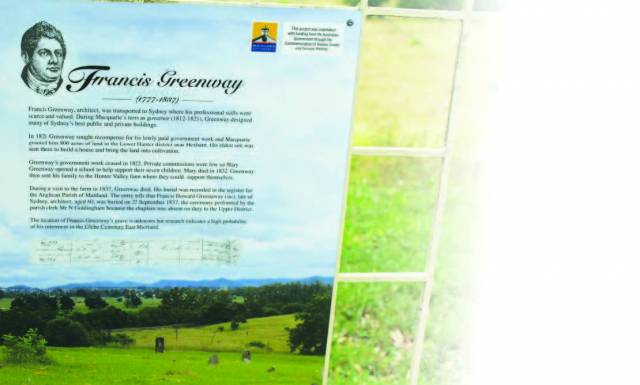
How the apron began

Francis Greenway, the son of a family of highly renowned architects and designers in England, was convicted of forgery and in 1812 was transported to the colony of NSW for seven years.
Little is known of Greenway’s imprison ment in England await - ing transportation, nor of his fearful and nightmare voyage to Australia in the convict ship General Hewitt. One can only assume he was treated like any other convicted felon.
However, Greenway’s luck changed when Governor Macquarie read of his qualifications and family background. Macquarie had vast visions of huge stone buildings of ornate design to be built all over the settlement. He had the material, huge supplies of rock and stone, an unlimited supply of labour (hundreds of convicts) but no one to design and oversee the construction of buildings, most of which still stand proudly and majestically today.
Governor Macquarie immediately summoned Greenway and put him to work. Whilst Greenway was an argumentative and quarrelsome man by nature, he quickly saw the advantages against being a member of the ‘Chain Gang’ and subsequently designed some of Australia’s most historic buildings.
In 1814, the 46th Regiment arrived in Sydney Town and two years later, Capt John Piper invited W Bro Captain Sander - son to conduct a masonic foundation stone laying ceremony at his new mansion at Point Piper, known as ‘Elisa’.
A major problem immediately arose as, though most, if not all in the Regiment were masons, none had brought their regalia, laughing at the thought of a mas - onic service or meeting being held in a convict settlement halfway around the world.
Governor Macquarie immediately saw opportunity and summoned Greenway, demanding that he design and indeed manufacture a unique masonic apron for the occasion. Greenway told the Governor the task was impossible due to lack of suitable materials but the Governor, determined to make his vision a reality, sternly reminded Greenway he was a ‘Ticket of Leave’ convict and to get on with the job.
Greenway had scant enough material to make aprons for the high ranking lodge officers, let alone the Master Masons and with the date of the stone laying fast approaching, he simply painted the design of the Master Mason’s apron on to a white lambskin and thus, the Australian masonic apron, which we love and respect so much, was humbly born.
Knowing well what Governor Macquarie’s reaction might be at the makeshift creation and dreading the thought of what would probably happen to the soldier’s white trousers and red coats in the hot Australian sun with the pitch-based paints, he did not divulge his creation until the day of the stone laying.
Greenway’s fears were unfounded; the day was a huge success and as a mark of gratitude, combined with all the other contributions to the settlement over the years, the Governor gave Greenway a ‘Land Grant’ of some 800 acres in the Hunter Valley, near Hexham, where Greenway’s son built a home.
In 1837, Greenway visited the family farm and at the age of 59, died of typhoid. On 25 September, he was buried in an unmarked pauper’s grave in Glebe Cemetery in East Maitland. The cemetery is easily found as it is at the end of Glebe Street which is a continuation of George Street, East Maitland. Here, somewhere in this grassy paddock in which aging headstones are scattered, is the final resting place of Francis Greenway.
A monument overlooking the cemetery and reflecting the great works and deeds of Greenway has been erected to the designer and creator of the Australian masonic apron, a symbol recognised throughout the world and which has been adopted by many countries in the southern hemisphere, including South Africa and New Zealand.
Article extracted from Freemason magazine, September 2014, page 20.


